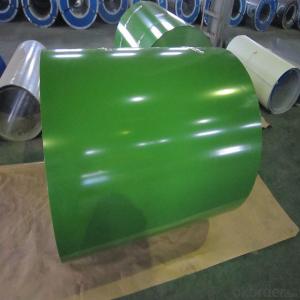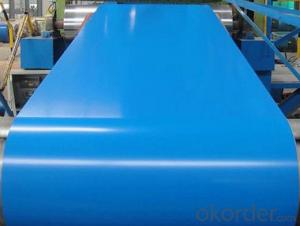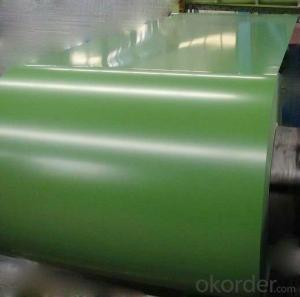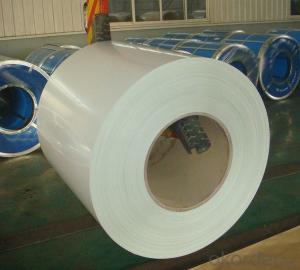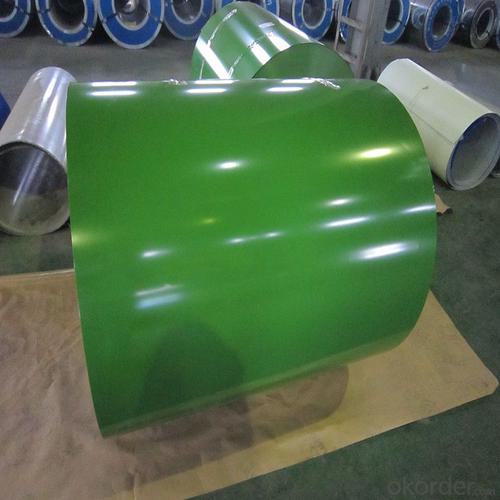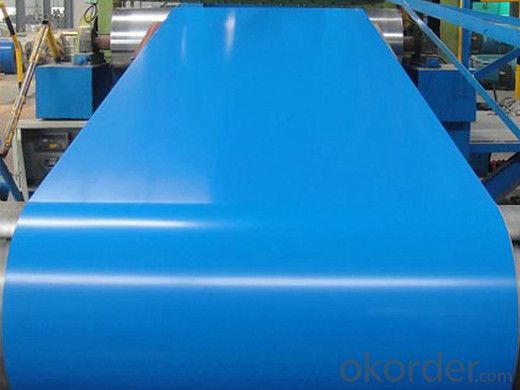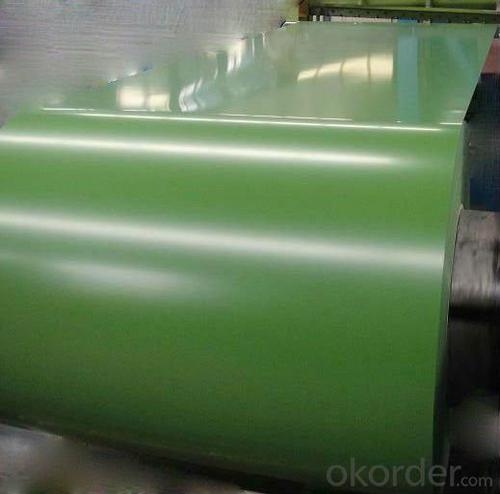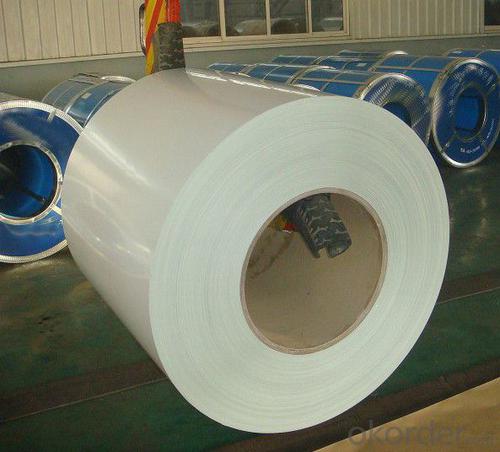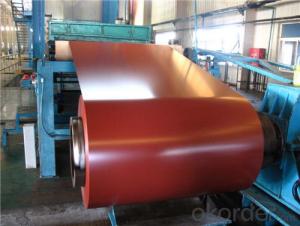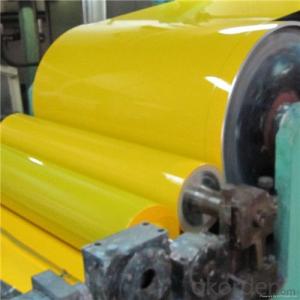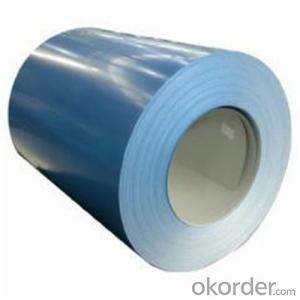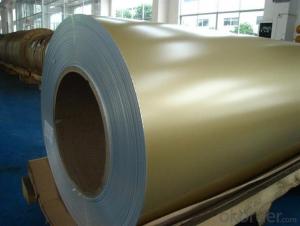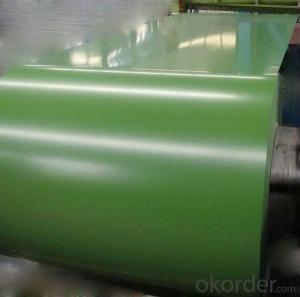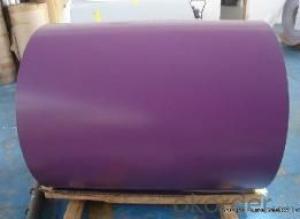Prepainted Rolled steel Coil for Construction Roofing
- Loading Port:
- Shanghai
- Payment Terms:
- TT OR LC
- Min Order Qty:
- 50 m.t.
- Supply Capability:
- 30000 m.t./month
OKorder Service Pledge
OKorder Financial Service
You Might Also Like
Structure of Prepainted Rolled steel Coil for Construction Roofing
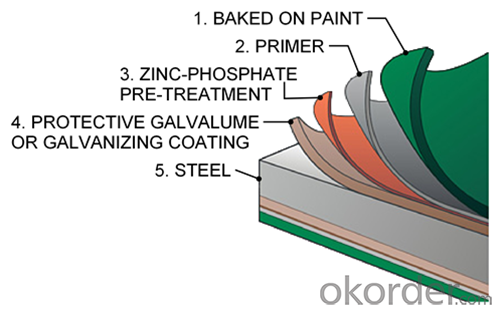
Description of Prepainted Rolled steel Coil for Construction Roofing
Prepainted Rolled steel Coil is a kind of coated steel coil/sheet. With the cold rolled steel of different strength and thickness as substrate, it is produced through applying Al-Zn coat on both faces by hot dip process. In its coating, Al accounts for about 55%, Si 1.6%, while the remaining is Zn. Aluminum zinc coils enjoys both the physical protective feature and durability of Al and the electrochemical protective property of Zn. And its surface has bright silver color and regular embossed-like figure, which are highly decorative.
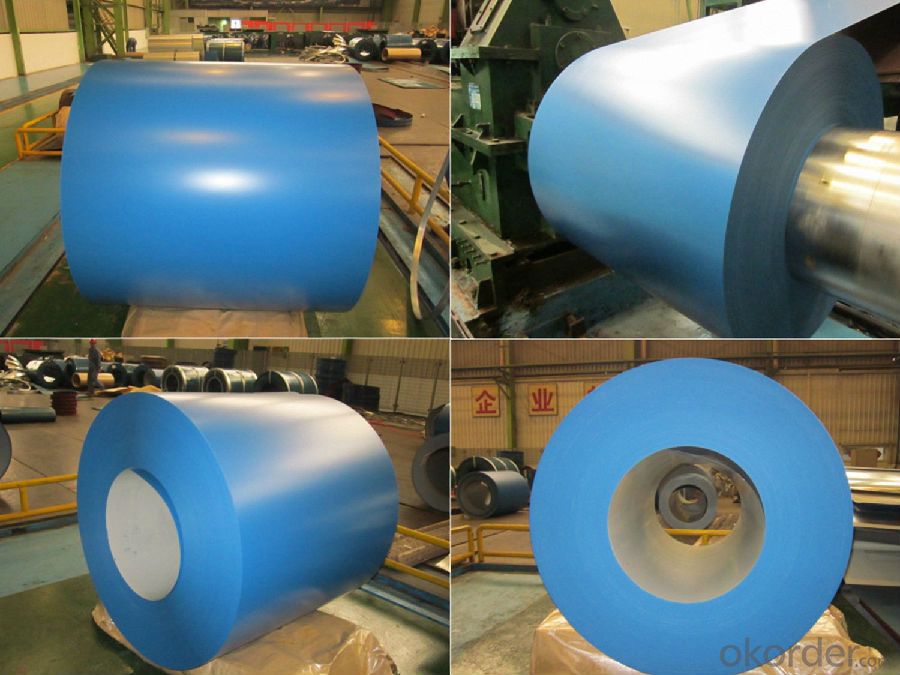
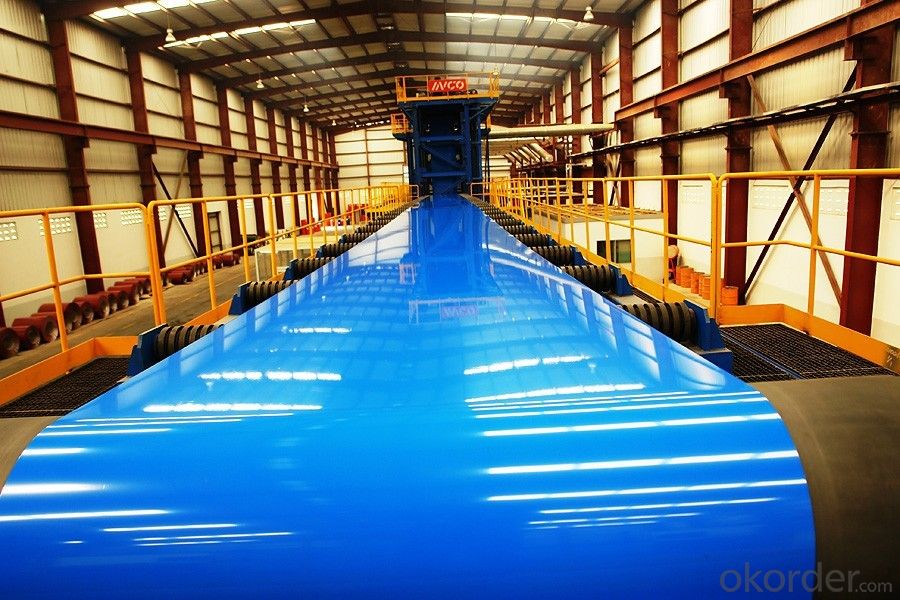
Main Feature of Prepainted Rolled steel Coil for Construction Roofing
1.Corrosion resistance: It mainly depends on the aluminum protection. When the zinc being worn, the aluminum will form a dense layer of aluminum oxide, resist corrosion material to prevent further corrosion inside.
2. Heat resistance: Aluminum zinc alloy steel sheet has excellent heat resistance, can withstand high temperatures over 300 centigrade, and is similar with aluminized steel high temperature oxidation resistance. It often used in chimney pipes, ovens, fluorescent lighting device and the device cover.
3. Heat reflective: Galvanized steel plate heat-reflective high rate is twice as galvanized steel, often used to make insulation materials.
4. Economy: Because density of 55% AL-Zn is smaller than the density of Zn, so in the same weight and thickness of Galvanized zinc layer, aluminum-zinc steel plate is larger area more than 3% of galvanized steel sheet.
Applications of Prepainted Rolled steel Coil for Construction Roofing
1. Construction and building: roofing; ventilating duct; handrail; partition panel;etc.
2. Electric appliance: refrigerator; washing machine; refrigerator; DVD;etc.
3.Transportation: oil tank; road sign; etc.
4.Agriculture:barn; etc.
5.Others:vending machine; game machine; etc.
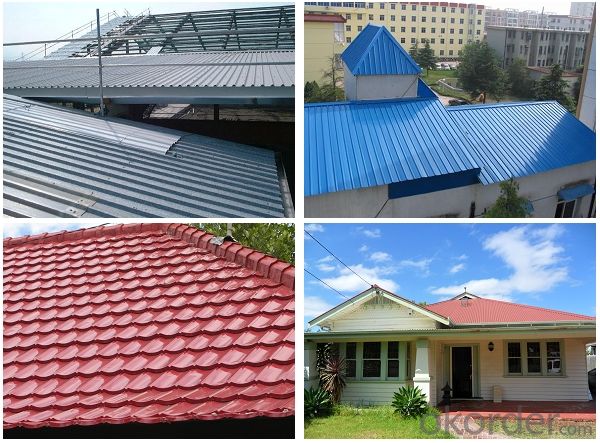
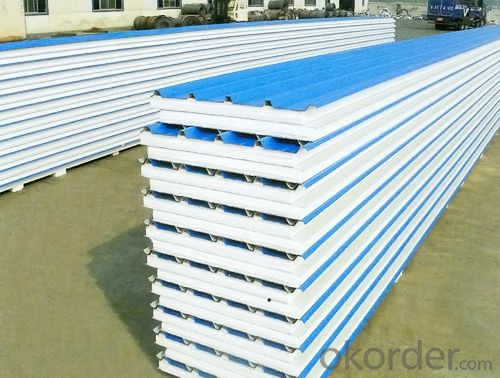
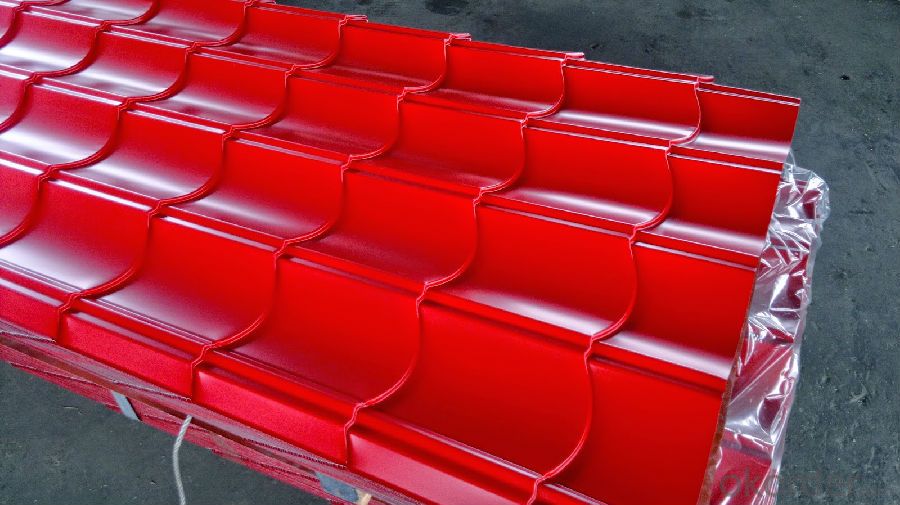
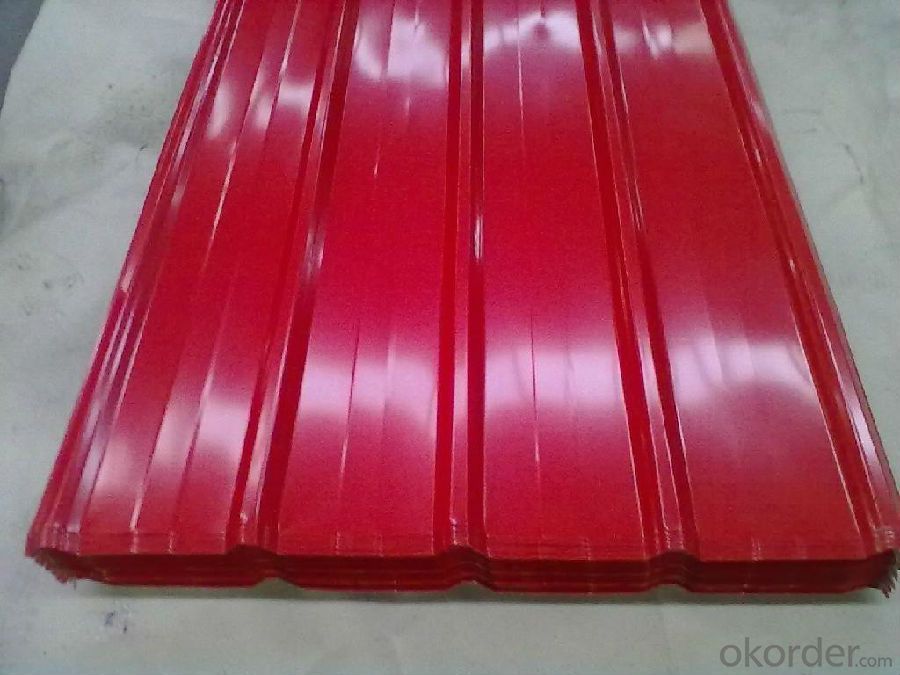
Specifications of Rolled steel Coil for Construction Roofing
Product | Prepainted Rolled steel Coil for Construction Roofing |
Material Grade | SGCC / SGCH / DX51D+AZ, etc |
Thickness | 0.2-3.0mm |
Width | 600-1500mm |
Tolerance | Thickness: +/-0.02mm , Width:+/-2mm |
Zinc-coating | AZ40-150g/m2 |
Technique | Raw material: Hot rolled steel coil --> Cold rolled_>hot dipped galvalume |
Surface | Dried, Chromated, Unoiled |
Spangle | Regular spangle , small spangle, zero spangle |
ID | 508MM |
Coil weight | 10MT max |
Export package | Cardboard inner sleeves, Waterproof paper, galvanized steel covered and steel strip packed |
FAQ of Prepainted Rolled steel Coil for Construction Roofing
We have organized several common questions for our clients,may help you sincerely:
1. What is the minimum order quantity ?
Our MOQ is 50mt for each size. And we will consider to give more discount if you make big order like 1000 tons and more. Further more, the more appropriate payment term your offer the better price we can provide.
2. How long can we receive the product after purchase?
Usually within thirty working days after receiving buyer’s advance payment or LC. We will arrange the factory manufacturing as soon as possible. The cargo readiness usually takes 15-25 days, but the shipment will depend on the vessel situation.
3. How to guarantee the quality of the products?
We have established the international advanced quality management system,every link from raw material to final product we have strict quality test;We resolutely put an end to unqualified products flowing into the market. At the same time, we will provide necessary follow-up service assurance.
- Q: I just bought a used Taurus 85 stainless 38 spl revolver, it's about 25 years old but looks like new. This is my first stainless steel gun. I'm wondering if there's any special things I need to be aware of or cleaning methods? I'm also wondering if stainless steel could rust? in theory stainless means it cannot get stained or rusty. I have a chrome bore AK, cleaning is always super easy, wondering of cleaning a SS revolver would be the same.
- Stainless steel does not rust. But your Stainless Barrel is not true stainless steel. True stainless steel is a mix of steel and chrome, and the chrome has a certaion percentage of the overal weight.. But a Stainless barrel does not contain enough chrome to be true stainless, so it can rust.
- Q: How are steel coils used in the manufacturing of shipping containers?
- Steel coils are used in the manufacturing of shipping containers as they are rolled into sheets, which are then cut and welded to create the walls, roof, and floor of the container. The high strength and durability of steel coils ensure that the shipping containers can withstand the rigors of transportation, protecting the goods inside.
- Q: How can I arbitrate quality of steel before purchasing it??
- The quality of the alloy can be very well be judged by its appearance and lustrous surface. The more luster on the surface the more refine will the steel be. To judge its tenacity and endurance, the alloy can be subjected to a series of procedures involving stress and shock. The reaction to these processes can determine whether the steel be fit for the purpose required.
- Q: I'm looking for the weight of different types of steel and haven't found anything helpful!!thank you
- Just know the type of steel ,its density. Density gives you weight per unit of volume. For example: The density of mild steel is approximately 7.85 g/cm^3 (0.284 lb/in^3) From above , you can say that 1 cm^3 of volume of mild steel have 7.85 gram weight.
- Q: How are steel coils used in the production of metal staircases?
- Steel coils play a vital role in manufacturing metal staircases. Typically made from high-quality carbon steel, these coils are initially uncoiled and then undergo a series of manufacturing processes to shape them into the required stair components. To begin the production process, specialized machinery is used to cut the steel coils into desired lengths. This allows for customized sizing to match the specific staircase design. Once cut, the coils are then shaped into various forms and profiles, such as stringers, treads, and risers, using bending, rolling, and stamping techniques. The use of steel coils offers several advantages in metal staircase production. Firstly, steel is renowned for its strength and durability, making it an ideal material choice for staircases that must bear heavy loads and endure frequent use. The flexibility of steel coils enables the creation of intricate and complex staircase designs, providing architects and designers with a wide array of options. Additionally, steel coils can be coated or finished in different ways to enhance their appearance and protect them from corrosion. This can include techniques like painting, powder coating, or the application of a protective layer such as galvanization. These finishes not only add aesthetic value to the metal staircases but also increase their longevity and resistance to wear and tear. In conclusion, steel coils are essential in the production of metal staircases as they provide the raw material that is shaped and formed into the necessary components. The strength, flexibility, and ability to be finished in various ways make steel coils a versatile and dependable choice for manufacturing durable and visually appealing staircases.
- Q: would you consider steel a flexible substance...i am debating this with my coworkers.Thanks,
- Yes, looking at it from an engineering standpoint. Depending on it's shape it can be used for many applications where flexibility is important. Steel springs for example, or guitar strings. Whenever you're debating these kinds of matters, it is important to keep in mind that the use of a material depends on the shape, the size and the weight it's going to be used in. A big block of steel will be used in a different manner as a piece of steel wire.
- Q: What are the dimensions of steel coils used in automotive part manufacturing?
- The dimensions of steel coils used in automotive part manufacturing can vary depending on the specific application and manufacturer. However, commonly used dimensions for steel coils in automotive part manufacturing range from 0.5 to 3 millimeters in thickness and 600 to 2000 millimeters in width. The length of the coils can also vary, typically ranging from several meters to several hundred meters. It is important to note that these dimensions are not fixed and can be customized to meet the specific requirements of each automotive part being manufactured.
- Q: tinplate,hot rolled coil,hot rolled sheet,cold rolled coil,cold rolled sheet,d bar,wire rod,triangle,structural steel,steel pipe,steel tube,carbon steel pipe
- Here are the top 30 steel producing companies in the world, listed by the megaton output: 1. 63.0 Mton Mittal Steel Company NV (Global) [2] 2. 46.7 Mton Arcelor (Europe) [3] 3. 32.0 Mton Nippon Steel (Japan) [4] 4. 30.5 Mton POSCO (South Korea) [5] 5. 29.9 Mton JFE (Japan) [6] 6. 23.8 Mton Shanghai Baosteel Group Corporation (China) 7. 19.3 Mton United States Steel Corporation (United States) 8. 18.4 Mton Nucor Corporation (United States) 9. 18.2 Mton Corus Group (Europe) [7] 10. 17.5 Mton Riva Group (Europe) [8] 11. 16.5 Mton ThyssenKrupp (Europe) [9] 12. 16.1 Mton Tangshan (China) 13. 13.9 Mton EvrazHolding (Russia) 14. 13.7 Mton Gerdau (Brazil) 15. 13.6 Mton Severstal (Russia) 16. 13.5 Mton Sumitomo Metal Industries (Japan) 17. 13.4 Mton SAIL (India) 18. 12.0 Mton Wuhan Iron and Steel (China) 19. 11.9 Mton Anshan (China) 20. 11.4 Mton Magnitogorsk (Russia) 21. 10.5 Mton Jiangsu Shagang (China) 22. 10.5 Mton Shougang (China) 23. 10.4 Mton Jinan (China) 24. 10.3 Mton Laiwu (China) 25. 10.3 Mton China Steel (Taiwan) [10] 26. 9.6 Mton Maanshan 27. 9.4 Mton Imidro 28. 8.7 Mton Techint 29. 8.7 Mton Usiminas (Brazil) 30. 8.5 Mton Novolipetsk (Russia)
- Q: I need help my new stainless steel cookware is sticking ? My first meal was nasty!
- Food sticks to stainless steel. Gourmet cooks love it for that very reason. Without sticking, foods won't sear properly. For the rest of those cooks out there, nonstick is often an easier option. If you want to make a go of the stainless, here are some tricks of the trade.... a)always preheat the pan on low-medium b)never put cold food into a hot pan. It will stick worse.Leave cold food on counter for 15 minutes before it hits the pan. c)after preheating the pan, add oil, or an oil/butter combo d)for foods like eggs, potatos, grilled cheese, nonstick is your best friend. e) when you take food out of pan, immediately wipe the pan out with a kitchen towel. Keeps cleanup from being a nightmare. f) don't wash pans in sink while hot. They will warp. Stainless takes some getting used to. Hope this helps!
- Q: What is the process of uncoiling a steel coil?
- The process of uncoiling a steel coil involves feeding the coil into a machine called a decoiler. The decoiler holds the coil and gradually unrolls it, allowing the steel to be straightened and fed into downstream manufacturing processes. This is typically done by using a combination of motorized rollers and tension control systems to ensure a controlled and smooth uncoiling process.
Send your message to us
Prepainted Rolled steel Coil for Construction Roofing
- Loading Port:
- Shanghai
- Payment Terms:
- TT OR LC
- Min Order Qty:
- 50 m.t.
- Supply Capability:
- 30000 m.t./month
OKorder Service Pledge
OKorder Financial Service
Similar products
Hot products
Hot Searches
Related keywords
